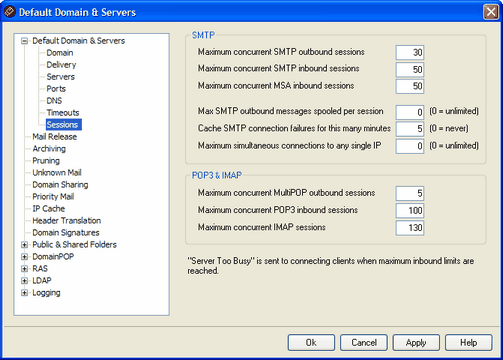
SMTP
Maximum concurrent SMTP outbound sessions
The value entered here represents the maximum possible outbound SMTP sessions that will be created when it is time to send outbound mail. Each session will send outbound messages until either the queue is empty or the Maximum SMTP outbound messages spooled per session setting has been reached. For example, if the outbound mail queue has twenty messages waiting when it is time to send mail and the value of this setting is five, then five sessions will be simultaneously created and each will consecutively deliver four messages.
This option is set to 30 by default, but you may wish to experiment with the number of sessions in order to find the setting that will yield the best performance for your bandwidth. It is possible to specify so many sessions that your bandwidth will be overloaded or your Windows machine will run out of resources and you will lose delivery efficiency. Remember, each SMTP session created by MDaemon will deliver messages consecutively and therefore four sessions delivering two messages each might perform better and faster than eight threads delivering only one message each. A good place to start would be five to ten threads when using a 56k modem and twenty to thirty for broadband
Maximum concurrent SMTP inbound sessions
This value controls the number of concurrent inbound SMTP sessions that the server will accept before it begins responding with a "Server Too Busy" message. The default value is 50.
Maximum concurrent MSA inbound sessions
Use this option to designate the maximum number of concurrent mail submission agent (MSA) inbound sessions allowed.
Maximum SMTP outbound messages spooled per session
This setting places a limit on the number of individual messages that each session will send before it stops delivering mail and frees itself from memory. Ordinarily, you should leave this control set to zero, which will cause each session to continue delivering messages until the queue is empty.
Cache SMTP connection failures for this many minutes (0 = never)
When an SMTP connection to a given host fails, MDaemon will cease trying to connect to that host for the number of minutes specified in this option. This can prevent MDaemon from needlessly attempting to connect to a problem host over and over again when, for example, it has multiple messages designated for that host and yet discovers that it is down when making the first delivery attempt. The default setting is 5 minutes. Use 0 if you do not wish to cache SMTP failures.
Maximum simultaneous connections to any single IP (0 = unlimited)
Use this option to limit the number of simultaneous connections that will be allowed to a single IP address during mail delivery. Use 0 if you do not wish to limit simultaneous connections.
This option is useful to prevent making too many connections at once to various IP addresses. During delivery, if a message would require a connection to an IP that would exceed this connection limit, then the connection is skipped and the next MX host (or smart host) is used. If no additional hosts are available the message is queued for the next delivery cycle. By default, this option is disabled, which preserves existing behavior. Also by default, connections to trusted IP addresses are exempt from this feature. However, if youd like to enforce it for trusted IPs you can set the following in the MDaemon.ini file:
[Sessions]
TrustedIPsUseConnectionLimit=Yes (default No)
Also by default, connections to IP addresses reserved for intranet use are exempt from this feature. These are 127.0.0.*, 192.168.*.*, 10.*.*.*, and 172.16.0.0/12. However, if youd like to enforce it for reserved IP addresses you can set the following in the MDaemon.ini file:
[Sessions]
ReservedIPsUseConnectionLimit=Yes (default No)
POP3 & IMAP
Maximum concurrent MultiPOP outbound sessions
The value entered here represents the maximum possible outbound POP sessions that will be created when it is time to collect MultiPOP mail. Each session will collect this type of mail until all MultiPOP servers have been processed, and all mail has been collected. For example, if there are fifteen MultiPOP sessions amongst all of your users and the value of this setting is set to three, then each session will collect mail from five MultiPOP sources.
You should experiment with the number of sessions to determine what number will yield the best performance for your bandwidth. It is possible to specify so many sessions that your bandwidth will be overloaded, or your Windows machine will run out of resources and you will lose processing efficiency. Remember that each POP sessions created by MDaemon will collect mail until all sources have been exhausted. Therefore, four sessions collecting mail from twenty sources might perform better and faster than twenty sessions collecting from a single source.
Maximum concurrent POP3 inbound sessions
This value controls the maximum number of concurrent POP inbound mail sessions that the server will accept before it begins responding with a "Server Too Busy" message.
Maximum concurrent IMAP sessions
This value controls the maximum number of concurrent IMAP mail sessions that the server will accept before it begins responding with a "Server Too Busy" message.